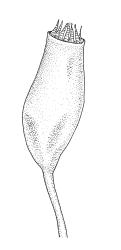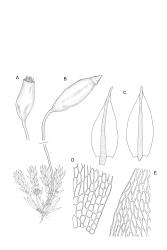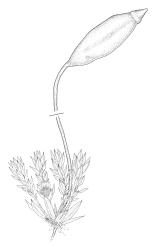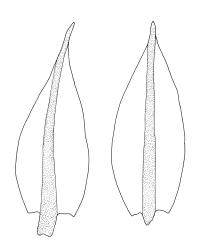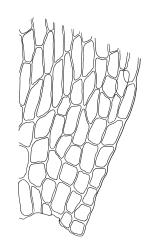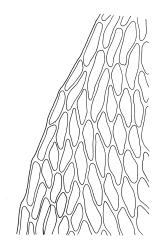- ≡ Brachymenium preissianum (Hampe) A.Jaeger, Ber. Thätigk. St. Gallischen Naturwiss. Ges. 1873–1874: 113 (1875)
- ≡ Gemmabryum preissianum (Hampe) J.R.Spence & H.P.Ramsay, Phytologia 87: 67 (2005)
- = Brachymenium coarctatum Hook.f., Handb. New Zealand Fl. 437 (1867) nom. illeg.
Plants yellow-green, very small, forming compact turves on calcareous rock. Stems pale brown and short, mostly <4 mm, branched by subperichaetial innovation, with sparse brown rhizoids, in cross-section with firm-walled cortical cells and a central strand. Leaves ± larger towards stem apex, erect when moist, scarcely altered when dry, oblong-lanceolate, acute, and aristate, 0.7–0.8 × c. 0.25 mm, with lamina c. ¾ or more of the total leaf length, concave, yellow-green throughout, entire, plane; upper laminal cells rhombic-hexagonal, firm-walled, (18–)27–39 × c. 6–9 µm and (3–)4–6:1; marginal cells slightly more oblong and elongate in 1–2 rows but not forming a distinct border; basal cells quadrate and firm-walled. Costa stout, yellowish, strongly excurrent to form an arista c. 20–25% of the total leaf length. Brood bodies (including tubers) absent.
Apparently dioicous (but often fruiting). Perichaetia near base of plant; perichaetial leaves lanceolate, to c. 1.4 mm. Perigonia terminal, conspicuous but uncommon. Setae to 10 mm, red-brown below, pale above, mostly strongly curved below capsule; capsules symmetric, horizontal to suberect, obovoid-cylindric, c. 1.5–2 × 0.8 mm, with an ill-defined neck ± equal to the urn in diameter, c. ¼ the total capsule length, and irregularly wrinkled when dry; mouth narrow; operculum high-conic. Exostome teeth lanceolate, yellow-brown below, finely ornamented, with the abaxial divisural line ± straight; endostome with a basal membrane c. ⅓ the height of the teeth and linear segments reaching c. ⅔ the height of the teeth; cilia absent or very rudimentary. Spores (8–)9–12 µm, nearly smooth.
Ochi 1970, fig. 4 (as Brachymenium preissianum); Catcheside 1980, fig. 143 (as Brachymenium preissianum).
Dixon (1926, p. 202) discussed the differences between N.Z. material and Brachymenium coarctatum Bosch & Sande Lac. from Java, which Mitten (in herb.) apparently considered to be conspecific. No material of B. coarctatum has been available for study, but the description and illustrations provided by Eddy (1996, p. 169) contrast sharply with N.Z. material. The problem of this Javan species is outside the scope of this Flora.
NI: N Auckland (Auckland City), S Auckland (Te Akatea), Gisborne (Marumaru Caves), Hawke’s Bay (Nūhaka, Wairoa, Māhia Peninsula, Maraetōtara, Pourērere, Tāhaenui), Wellington (Ruakōkoputuna); SI: Nelson (Nelson City), Canterbury (Arthur’s Pass), Otago (Ōamaru).
Australasian. Mainland Australia* and recorded from Tasmania (Spence & Ramsay 2006).
On limestone and other base-rich rock, including sandstone; rarely on clay banks. Predominantly at low elevations, but recorded from c. 350 m at Ruakōkoputuna and at subalpine elevations (near Arthur’s Pass). Gymnostomum calcareum is a frequent associate.
Material collected in the "Bealey Basin" in Canterbury L.D. (Martin 1946) (W. Martin, 16 Jan. 1944, CHR 490357) is anomalous for its occurrence on clay soil in an area of greywacke bedrock at a higher elevation than any other N.Z. collections. It has longer stems (to c. 10 mm), but in other features is characteristic of the species. Material cited by Dixon (1926, p. 202) from Mauriceville (Wellington L.D.) has not been seen.
New Zealand material of Bryum preissianum has been treated in Brachymenium by Dixon (1926), Sainsbury (1955), and Ochi (1970), in part because of the orientation of the capsules. The genus Brachymenium is lectotypified by Brachymenium nepalense Hook. (fide Ochi 1992; see also Spence & Ramsay 2006, p. 277), which is a far more robust and epiphytic plant of autoicous sexuality that has narrowly spathulate leaves strongly spiralled around the stem when dry, long-excurrent costae, long-necked and erect capsules in excess of 3 mm, and larger spores. The horizontal to suberect capsules found in Bryum preissianum are admittedly infrequent in Bryum, but in all other respects, including its sexuality, laminal areolation, costal development, capsule form, and peristome morphology, this species is well-placed in Bryum.



